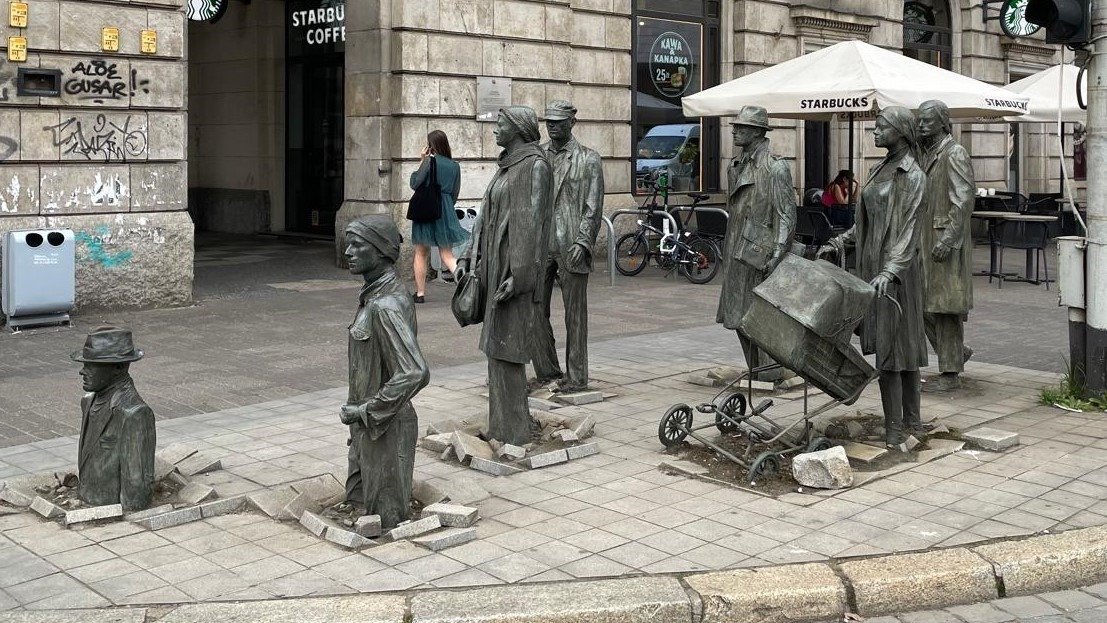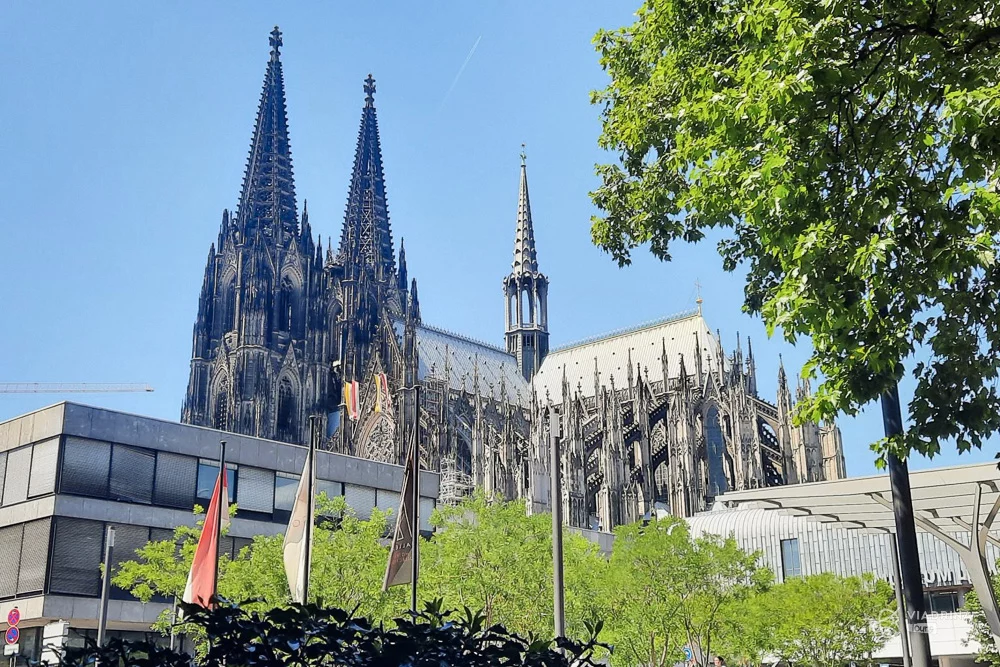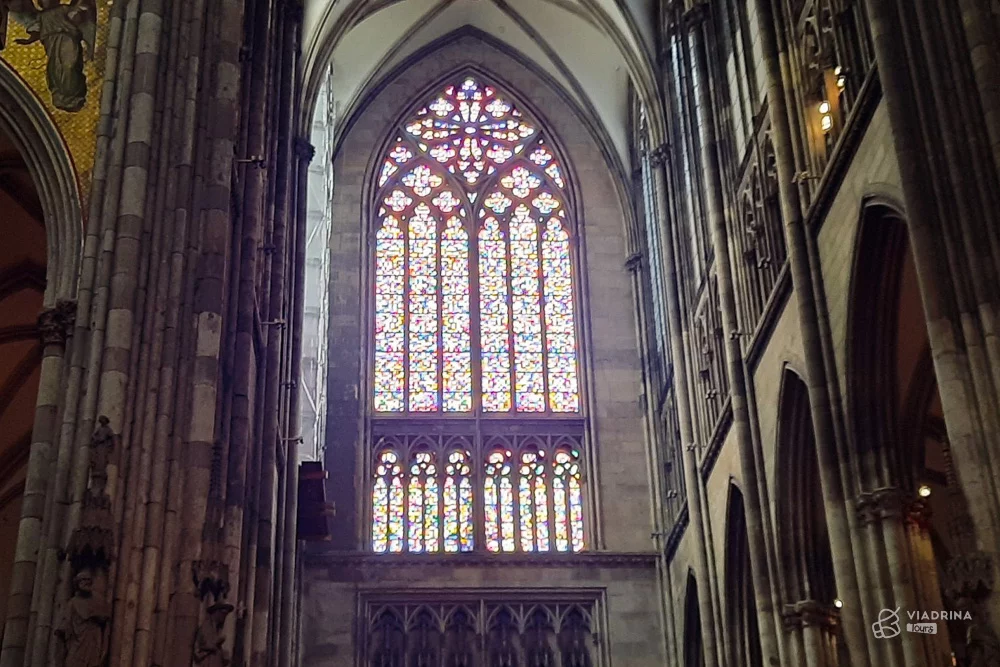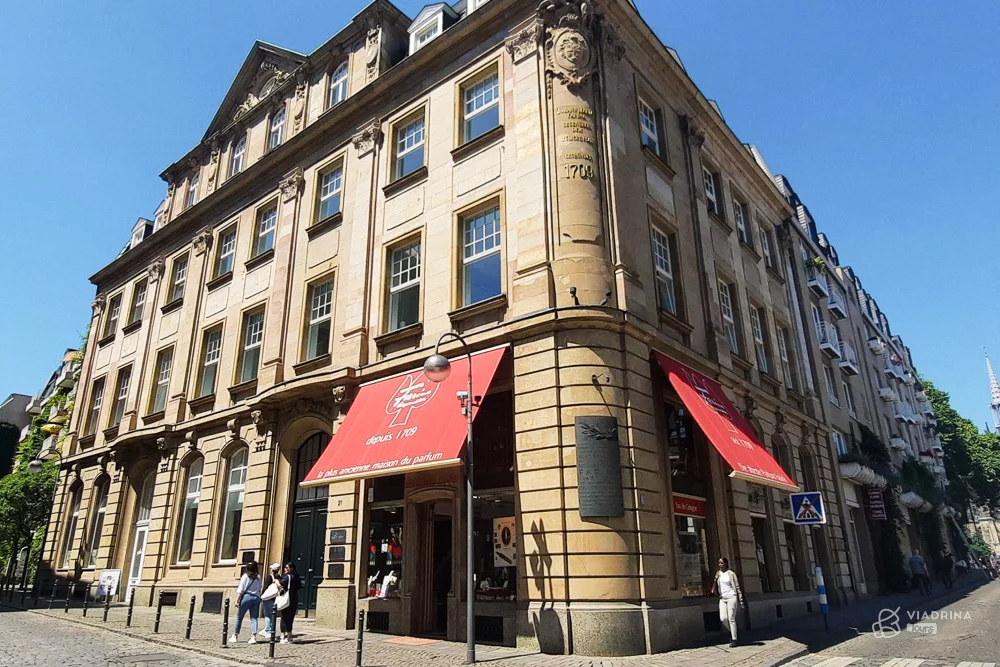
Are you wondering what to see in Cologne? It is not an easy answer, since the city belongs to one of the oldest in the German territory. Its history begins during the expansion of the Roman Empire, so you can imagine, there is a lot of antiquity to enjoy. But it’s not all yet. The Rhenish metropolis experienced its greatest flourishing during medieval times. It is when the relics of the Three Wise Men arrived in the city. That is why Colonia became a very important center of pilgrimage. Along with Jerusalem, Constantinople and Rome it attracted multitudes of believers. They called it “Holy Colony”. In addition, the city became famous for its fun carnival tradition and the fragrance that we all know as “eau de Cologne”. In this post we present the 5 emblematic places that you must visit during your stay in Cologne.

The Gothic Cathedral is number 1 on our list of must-see places in Cologne. It is one of the most spectacular monuments in all of Germany. It is a majestic Gothic construction located next to the Rhine River. Why in this town? As you can imagine, at that time it was difficult to transport the heavy and large quantities of stones for its construction, so the most convenient thing was to build the cathedral next to the river where the ships disembarked.
The history of the cathedral began in Roman times, when Cologne became an important city on the outskirts of the empire. The first church was built in the times of the Merovingians. A few centuries later it obtained a harmonic Romanesque silhouette. What happened then that is currently so spectacular?
We have to move in the time of Emperor Frederick I Barbarossa. This monarch between the years 1158-1174 undertook several military campaigns in Italy. During one of them, the German troops besieged Milan and after conquering it, looted the riches of the Lombard capital. According to legend, in 1164 the imperial chancellor Reynald of Dassel, who later became the archbishop of Cologne, took the most valuable part of the booty, the relics of the three wise men, to his new episcopal see. Since then, the Rhenish city has become a religious magnet for pilgrims from all over Europe. What did the believers bring with them? A lot of money of course!
We know very little about the architect of the cathedral, except that he bought a property in the city and that he was a genius. Without having modern technical equipment, this master mason designed a magnificent work of architecture. First, he had the foundations built 10 meters deep in the sandy soil on the banks of the Rhine. This was indispensable to support the weight of the stone of an estimated 120 thousand tons! It looks awesome? It’s not all yet! Second, Gerardus decided to use basalt – one of the hardest rocks in the world. Between it he ordered to put the layers of volcanic tuff, a soft and elastic stone. All covered with a special mortar, it had qualities similar to the current reinforced concrete. Crazy for those times!
Work began in 1248 when Archbishop Konrad von Hochstaden decided to replace the modest Romanesque church with the spectacular Gothic temple. The construction was never finished and it continued without great progress until the year 1560. Why did the works stop completely? For the dissemination of the new teachings of Martin Luther. The Protestant Reformation put an end to the cult of relics and many places of pilgrimage never returned to their golden days. That was indeed the case in Cologne. Without donations from believers, the city’s wealth is gone.
When was the construction of the Cologne Cathedral finished? It was in the year 1880, shortly after the creation of the Second German Empire. A decade later, in 1894, the massive construction of the Central Train Station was completed. Located next to the cathedral, it represented at the time the rise of industrial progress. It had the largest steel arches in the world.
With both constructions the Prussian authorities wanted to convey an important message. On the one hand, we care about taking care of the legacy of the Holy Roman Empire. On the other, we are a technologically advanced country and under the command of the Kaiser we are capable of creating the best future for Germany.
Once learning about the history it is worth exploring the incredible interiors. Entrance to the cathedral is free. It is impossible for us to cover all the spectacular works of art found within. It must be taken into account that the cathedral suffered damage during the bombings of the Second World War. However, we decided to point out what we found majestic.

Walking through the interiors, in the southern part of the transept, you will find the newest work in the cathedral. It is an extensive stained glass window made up of 11,000 colored crystals designed by the famous painter Gerhard Richter. The author is considered one of the greatest contemporary artists in Germany. He began his career in using stark photographs as the basis for his paintings. He then evolved playing with colors and abstract shapes. For some of the local clergy, the work did not square with the religious character of the cathedral. For others, the composition of colors referred to virtual reality, causing questions about spirituality in the digital age. Do you think it is the most suitable place for this type of art? Difficult to answer. However, it is worth contemplating the work reflecting on transcendence.

The number 2 place in our list of the places you must visit in Cologne occupies the Roman Germanic Museum. As we already mentioned, Colonia is one of the oldest cities in the country. Its foundation is closely linked to a true character in Roman history. Who is it about? From Agrippina the Less, the sister of Emperor Caligula, wife and niece of Claudius, and the mother of Nero. If you like to read about the dark intrigues, betrayals, plots and incest, we recommend her biography.
She was born in Cologne, when this site was just a newly established military camp. Her father named Germanicus was a popular and prominent Roman general, known for his campaigns in Germany. In order to ennoble the place of origin of Agrippina it was decided to grant Colonia full rights of the Roman municipality known since then as Colonia Claudia Ara Agrippinensium. Later, the city became the capital of the province of the empire called Germania Inferior.
The most worth seeing in the exhibition is the Dionysus mosaic. In 1941, during the construction of an air shelter, this precious work of art was discovered. Imagine that in the 3rd century AD the entire block was occupied by a representative Roman villa. As always, each domus had a peristyle and an internal space called the Triclinium. The floor of this courtyard was decorated with a beautiful 70 square meter mosaic representing different scenes related to the cult of Dionysus/Bacchus, the seasons of the year and agricultural activities. The central part occupies the image of the drunk Dionisio with his lover Ámpelo. There are different versions of this myth. In his essence, the young Ámpelos loses his life and recovers it like a vine branch. Thus the Romans explained how wine had made its first appearance on earth. You should not be surprised by this mythical theme in Cologne, since from Roman times to the present day the Rhineland region is known for its wine production.
What else can you visit? The multi-storey rooms house an opulent collection of busts, tombstones or gold and silver work and crafts. What caught our attention the most was the monument to the veteran Lucius Poblicius and a reconstruction of a 2nd century Roman coach. One realizes the impact of the Roman empire on the formation of Europe. Hail Caesar!

Number 3 on our list occupies an indispensable place during your visit in Cologne. It is the famous Casa Farina – the perfume museum and the original store of one of the most recognized brands worldwide – Eau de Cologne. The history of this fragrance begins at the beginning of the 17th century, when a young Italian Juan Maria Farina arrived in Cologne. His family, from Piedmont, had a long history of manufacturing perfumes. they had extensive knowledge of the distillation and maceration processes. Eau de Cologne was invented for the first time in the year 1709. The fragrance was a success because its smell was less heavy than French perfumes. In a short time he had a huge success among the European courts and the wealthiest people.
The inventor, Juan María Farina, mentioned in his letters that missing faraway Italy, he wanted to recreate the particular smell of his native land: a beautiful sunrise after the rain, a composition of oranges, lemons, grapefruit, bergamot , flowers and fruits.
In the building you can follow the history of the eight generations building the reputation of the brand. You will find out about the famous people who used the perfume, such as Napoleon Bonaparte, European monarchs or Simón Bolívar. It is worth booking a guided tour, where in the cellars you are presented with a guide in Spanish, all the essences, their origin and part of the production process. An unforgettable experience. Visits in Spanish can be booked through the page. Prices vary between 5 to 9 euros. Also tours in Spanish are not always available. You can check it here.

It is an extravagant work of architecture located next to the cathedral. They say the undulating shape of the roof must mimic the regular waves of the Rhine River. The museum was established by a Ludwig couple, wealthy chocolate makers, who donated more than 350 works of contemporary art. The characteristic building was built in 1986 and today houses the Cologne Museum and Philharmonic.
It is one of the best collections of pop art in the country. You can enjoy the works of Andy Warhol (the double Elvis Presley), or Roy Fox Liechtenstein (M-Maybe – the famous blonde cartoon woman). In addition, they have the largest collection of works by Pablo Picasso in Germany! You can admire his Harlequin and Woman with artichoke. We particularly enjoy the German artists – Otto Dix, the iconic interwar painter, Sigmar Polke and previously mentioned Gerhard Richter – with his painting the nude woman on the stairs. Regular admission costs 11 euros, but if you are a fan of contemporary art you will enjoy it to the fullest.
Another curious fact. He built is basically “embedded” in the banks of the Rhine River. The Philharmonic concert hall is located under the Heinrich-Böl square where you can access the museum, or take the walk to the waterfront. It turns out that due to flaws in the construction of the roof of the Philharmonic, the footsteps of passers-by cause a lot of noise and annoyance during concerts. It is the reason why, and we had to see it, during performances and rehearsals, security officials almost completely close off the square, allowing only walk along the edges. The annual expense of this operation? It is estimated that around 100,000 euros. However, it is still much cheaper than rebuilding the entire building. Pragmatism above all!

Number five, which closes our list of places worth seeing in Cologne, is located in the port district, next to the Rhine River. This entire area, located about a 15-minute walk from the historic center, has a fascinating mix of architecture. The construction of the new river port began during the Napoleonic wars. However, the real flourishing of the site came a few decades later with the development of steamships and their increasing navigation on the Rhine River.
You will be able to appreciate monuments from the industrial era, including the original buildings of the warehouses, customs, port cranes and the old headquarters of the port administration. Now it is a very busy area full of people strolling along the banks of the river. In the summer you can find many restaurants, bars and fast food stalls. What impresses the most are 3 tall apartments erected between the years 2006-2008. They have a height of about 60 meters and imitate port cranes in the form of an inverted letter L. It is an interesting idea to amalgamate the historical part with a project of futuristic architecture. In addition, the following museums can be found in the area:
This ends our list of the top 5 places in Cologne. However, the city has other outstanding monuments. Some, such as the Town Hall, the Church of San Martin or the sites linked to Kolsch beer and the Carnival, we show you during our free tour of the historic center of Cologne. If you want to discover new experiences during your travels, here we tell you the best German festivities. Tell us in the comments how was your visit to this beautiful metropolis of North Rhine-Westphalia? See you in Cologne!

In this blog we are going to tell you about 10 interesting aspects of the life of King Frederick II the Great of Prussia – one of the most…
In this guide we present you 6 Places in Jewish Warsaw you must visit to discover the Jewish history of the city.
In this post we present you the 5 free places in Frankfurt you have to visit. Are you ready to take advantage …